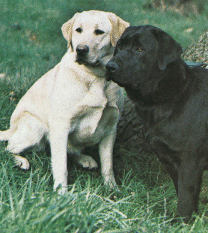
Genetic terms concerning genes and alleles.
The Labrador Retriever race has the coat colour types yellow and black. Thus
considering a gene for yellow
coat colour, it points at both a locus and an allele. This corresponds to the early understanding of
genes where there was a variant (yellow) corresponding to the wild type (black).
The term 'gene' should not be used when talking about a DNA polymorphism with more
alleles in non-coding sequences. Instead the term 'locus' should be used. This terminology
also ought to be used in connexion with
genetic variants. There is not always a sharp separation between gene and locus,
and between gene and allele in practice.
So when gene frequencies are mentioned in this chapter, it would include genes in the traditional sense and alleles in
non-coding DNA sequences (loci).
Figure 2.1.
Albumin type is codominantly inherited, which means that both
alleles can be seen directly on the gel. The phenotypes,
seen on the gel, are an SS, an SF and an FF albumin type.After the
electrophoresis of the serum samples
the gel is stained with Amidoblack.
 |
Gene counting method, Co-dominant inheritance, Phenotype = Genotype
Data from a study of albumin types in Danish German Shepherd will be used
to explain the principles, see Table
1 section 2.4. When serum is tested on an electrophoresis gel there
is a 'fast' and a 'slow' albumin allele designated as the F and S allele,
respectively. The investigations
have been carried out by K. Christensen et al. 1985,
Hereditas, 102:219-223.
The following numbers of the 3 albumin genotypes was found in a population.
--------- Genotype SS SF FF Total Number 36 47 23 106 Frequency 0.34 0.44 0.22 = 1.00 ----------
The frequency of the SS type is calculated as 36/106 = 0.34
The calculation of gene frequency for S is based on the gene counting method, every SS individuals have 2 S genes and a SF individual has 1. This is relative to all genes in the population, which are 2*106.
The frequency of S is calculated as p = (2*36 + 47)/(2*106) = 0.56
do F do q = (2*23 + 47)/(2*106) = 0.44
------
1.00
The frequency of the first allele is normally given the symbol p and the second the symbol q. If there are more alleles the symbols are continued alphabetically.
An allele frequency corresponds to a probability, and therefore the sum of alleles (gene frequencies) is 1. For basic statistical formulations, or Samuels, Statistics for Life Science
Examples of multiple alleles (more than two alleles)
In section 1.5 the segregation of a mikrosatellite in a swine family was
mentioned. There are 3 alleles as can be seen in the gel in Figure 2.2.
The allele designations are 209, 199 and 195
Figure 2.2 Segregation of genetic variation (mikrosatellite) in a locus in a swine family detected by gel electrophoresis. The boar Cup carries the alleles 209 and 195 and sow 400 carries the alleles 199 and 195. Most of the animals are heterozygotes each with two bands. The homozygotes have only one band. Gel prepared by Merete Fredholm |
 |
The calculations of the gene frequencies by means of the gene counting methods are shown below. For the allele there are 18 heterozygotes and 2 homozygotes (no bands in the lower line). Count for yourself! For the allele '199' there are 12 heterozygotes and 0 homozygotes (all 12 have bands in '199' line plus one other band in either '195' or '209'). Count again!
Frequency of '209' calculated as p = (2*2 + 18)/(2*44) = 0.250 do '199' do q = (2*0 + 12)/(2*44) = 0.134 do '195' do r = 1 - p - q = 0.616
The last allele frequency is most easily calculated as a difference, since the sum of the allele frequencies is 1.
Figure 2.3. The Labrador Retriever with the normal colour
type black and with segregation of the recessive
yellow coat colour type due to alleles in the extension locus.
 |
The square root method, Dominant inheritance
In a population of Labrador Retrievers the following numbers of the two phenotypes was found:
--------- Phenotype Black Yellow Total Genotype EE+Ee ee Number 182 18 200 Frequency 0.91 0.09 = 1.00 ----------
The black colour type represents both homozygotes and heterozygotes. If two random black dogs are mated, they will occasionally get yellow offspring. This happens when both dogs by random are of the colour genotype Ee.
The gene counting method implies that the phenotype is equal to the genotype, but this is only the case for yellow. For an offspring to become yellow, it should have an e gene from both its sire and dam, each with a probability of q. Therefore, the probability multiplication rule can be applied to calculate the frequency of ee individuals which corresponds to q2. From the data material it is estimated to be 18/200 = 0.09
The square root of 0.09 is q = 0.30.
The frequency of the black gene in the population becomes p = 1 - q = 0.7.